Dear Readers,
It is time for a new post in my favorite series - Canonical References in BBC Sherlock episodes.
Scripted by Mark Gatiss, this episode is based on the original story: The Hound of the Baskervilles. Here are the references to Arthur Conan Doyle's original stories:
1. Sherlock makes his entrance at 221 B Baker Street with a harpoon and blood all over himself. A surprised John asks him: “You went on the Tube like that?” - In the original story, The Adventure of Black Peter, Dr Watson notes that Sherlock Holmes “strode into the room, his hat upon his head and a huge barbed-headed spear tucked like an umbrella under his arm.” Dr John Watson asks Holmes: “Good gracious, Holmes!....You don't mean to say that you have been walking about London with that thing?”
2. In the next scene, at 221 B Baker Street, Sherlock is seen walking around impatiently, while holding the harpoon. - Dr John Watson mentions in The Adventure of the Bruce-Partington Plans: “..my comrade's impatient and active nature could endure this drab existence no longer. He paced restlessly about our sitting-room in a fever of suppressed energy, biting his nails, tapping the furniture, and chafing against inaction.”
3. Sherlock asks John: “Nothing?” referring to the newspapers that John is reading – In The Adventure of the Bruce-Partington Plans, Sherlock Holmes asks Dr John Watson: “Nothing of interest in the paper, Watson?”
4. John replies to Sherlock's above question: “Military coup in Uganda....another photo of you with the (deerstalker)... Cabinet re-shuffle”. Sherlock responds: “Nothing of importance! Oh, God!” – In The Adventure of the Bruce-Partington Plans, Dr John Watson writes: “I was aware that by anything of interest, Holmes meant anything of criminal interest. There was the news of a revolution, of a possible war, and of an impending change of government; but these did not come within the horizon of my companion. I could see nothing recorded in the shape of crime which was not commonplace and futile. Holmes groaned and resumed his restless meanderings.”
Click on the link below to buy your copy of Season 2:
5. A frustrated Sherlock Holmes starts looking around desperately for drug/artificial stimulant(s): “John, I need some. Get me some!” – In The Adventure of the Yellow Face, Dr John Watson writes about Sherlock Holmes: “Save for the occasional use of cocaine, he had no vices, and he only turned to the drug as a protest against the monotony of existence when cases were scanty and the papers uninteresting.”
6. Sherlock tries to bribe John into getting his some cocaine: “I will let you know next week’s lottery numbers” – Reference to Watson’s gambling habit as mentioned in this exchange from The Adventure of Shoscombe Old Place - Sherlock Holmes: “By the way, Watson, you know something of racing?” Dr Watson: “I ought to. I pay for it with about half my wound pension.”
7. Sherlock refers to his “secret supply” while searching his slippers – In The Adventure of the Musgrave Ritual, Dr Watson writes about Sherlock Holmes' habits: “...But with me there is a limit, and when I find a man who keeps his cigars in the coal-scuttle, his tobacco in the toe end of a Persian slipper... then I begin to give myself virtuous airs. ”
8. Mrs Hudson’s reaction to Sherlock’s (seemingly childish) fascination with the harpoon: “How about a nice cuppa? And perhaps you could put away your harpoon” – In A Study in Scarlet, when Stanford introduces Dr Watson to Sherlock Holmes, Holmes is working on a chemical experiment. Dr Watson writes about Holmes' enthusiasm about his discovery: “ "Ha! ha!" he cried, clapping his hands, and looking as delighted as a child with a new toy.”
9. Sherlock responds to Mrs Hudson: “I need something stronger than tea. Perhaps 7 percent stronger” – In The Sign of the Four, Dr Watson gets angry with Sherlock Holmes for using drugs and asks him whether he took morphine or cocaine on that particular day. Holmes responds: “It is cocaine,....a seven-per-cent solution.”
10. Sherlock’s deduction about Mrs Hudson’s recent activities by observing the flour on her sleeves and tiny foils on her thumbnail – In A Study in Scarlet, Sherlock Holmes explains about the Science of Deduction and Analysis: “By a man's finger nails, by his coat-sleeve, by his boot, by his trouser knees, by the callosities of his forefinger and thumb, by his expression, by his shirt cuffs—by each of these things a man's calling is plainly revealed.”
11. Sherlock correctly recognizes the perfume being worn by Mrs Hudson as “Casbah Nights” and advises her to read his blog on the identification of perfumes – Reference to this line from The Hound of the Baskervilles: “There are seventy-five perfumes, which it is very necessary that a criminal expert should be able to distinguish from each other, and cases have more than once within my own experience depended upon their prompt recognition.”
12. Sherlock's remark about his mind: “Mine’s like an engine, racing out out of control… A rocket, tearing itself to pieces trapped on the launch pad... I need a case!” – In The Adventure of Wisteria Lodge, Sherlock Holmes tells Watson: “My dear Watson, you know how bored I have been since we locked up Colonel Carruthers. My mind is like a racing engine, tearing itself to pieces because it is not connected up with the work for which it was built.”
13. John retorts: “You have just solved one! By harpooning a dead pig, apparently” - Reference to the plot of The Adventure of Black Peter in which Sherlock Holmes solves the mystery behind the murder of Captain Black Peter.
14. Sherlock expresses his anger and frustration at being asked by a prospective client to find her missing rabbit “Bluebell” – In The Adventure of the Copper Beeches, Sherlock Holmes complains to Dr Watson about a letter he receives from Violet Hunter: “As to my own little practice, it seems to be degenerating into an agency for recovering lost lead pencils and giving advice to young ladies from boarding-schools. I think that I have touched bottom at last, however. This note I had this morning marks my zero-point, I fancy.”
15. Sherlock switches off Henry's TV interview and asks Henry Knight to repeat the story. Sherlock's reason: “I prefer to do my own editing” – In the Canon, Sherlock Holmes often asks clients to repeat their case history to Holmes and Dr Watson, despite the availability of other sources of information.
In The Adventure of the Red-Headed League, Sherlock Holmes tells his client, Jabez Wilson: “I ask you not merely because my friend Dr. Watson has not heard the opening part but also because the peculiar nature of the story makes me anxious to have every possible detail from your lips”
In A Study in Scarlet, Sherlock Holmes makes a similar request to John Rance, the police constable. When John protests that he has already filed a police report, Holmes offers him a half-sovereign as an incentive and explains: “We thought that we should like to hear it all from your own lips...... Just let us hear it all in your own way as it occurred.”
16. Sherlock interrupts Henry when the latter is describing Dartmoor's beauty: “It is an amazing place. It is like nowhere else...It’s sort of black but beautiful.” Sherlock's response: “Hmm. Not interested, moving on.” – In The Adventure of the Retired Colorman, Sherlock Holmes sends Dr John Watson to collect information about Josiah Amberley. Dr Watson returns and explains about Josiah's house: “You know that particular quarter, the monotonous brick streets, the weary suburban highways. Right in the middle of them, a little island of ancient culture and comfort, lies this old home, surrounded by a high sun-baked wall mottled with lichens and topped with moss, the sort of wall...”. Holmes' angry response: “Cut out the poetry, Watson...I note that it was a high brick wall.”
I will be listing the remaining nods in another post.
Click here to read all my posts about BBC Sherlock.
It is time for a new post in my favorite series - Canonical References in BBC Sherlock episodes.
Scripted by Mark Gatiss, this episode is based on the original story: The Hound of the Baskervilles. Here are the references to Arthur Conan Doyle's original stories:
1. Sherlock makes his entrance at 221 B Baker Street with a harpoon and blood all over himself. A surprised John asks him: “You went on the Tube like that?” - In the original story, The Adventure of Black Peter, Dr Watson notes that Sherlock Holmes “strode into the room, his hat upon his head and a huge barbed-headed spear tucked like an umbrella under his arm.” Dr John Watson asks Holmes: “Good gracious, Holmes!....You don't mean to say that you have been walking about London with that thing?”
3. Sherlock asks John: “Nothing?” referring to the newspapers that John is reading – In The Adventure of the Bruce-Partington Plans, Sherlock Holmes asks Dr John Watson: “Nothing of interest in the paper, Watson?”
4. John replies to Sherlock's above question: “Military coup in Uganda....another photo of you with the (deerstalker)... Cabinet re-shuffle”. Sherlock responds: “Nothing of importance! Oh, God!” – In The Adventure of the Bruce-Partington Plans, Dr John Watson writes: “I was aware that by anything of interest, Holmes meant anything of criminal interest. There was the news of a revolution, of a possible war, and of an impending change of government; but these did not come within the horizon of my companion. I could see nothing recorded in the shape of crime which was not commonplace and futile. Holmes groaned and resumed his restless meanderings.”
5. A frustrated Sherlock Holmes starts looking around desperately for drug/artificial stimulant(s): “John, I need some. Get me some!” – In The Adventure of the Yellow Face, Dr John Watson writes about Sherlock Holmes: “Save for the occasional use of cocaine, he had no vices, and he only turned to the drug as a protest against the monotony of existence when cases were scanty and the papers uninteresting.”
6. Sherlock tries to bribe John into getting his some cocaine: “I will let you know next week’s lottery numbers” – Reference to Watson’s gambling habit as mentioned in this exchange from The Adventure of Shoscombe Old Place - Sherlock Holmes: “By the way, Watson, you know something of racing?” Dr Watson: “I ought to. I pay for it with about half my wound pension.”
8. Mrs Hudson’s reaction to Sherlock’s (seemingly childish) fascination with the harpoon: “How about a nice cuppa? And perhaps you could put away your harpoon” – In A Study in Scarlet, when Stanford introduces Dr Watson to Sherlock Holmes, Holmes is working on a chemical experiment. Dr Watson writes about Holmes' enthusiasm about his discovery: “ "Ha! ha!" he cried, clapping his hands, and looking as delighted as a child with a new toy.”
9. Sherlock responds to Mrs Hudson: “I need something stronger than tea. Perhaps 7 percent stronger” – In The Sign of the Four, Dr Watson gets angry with Sherlock Holmes for using drugs and asks him whether he took morphine or cocaine on that particular day. Holmes responds: “It is cocaine,....a seven-per-cent solution.”
10. Sherlock’s deduction about Mrs Hudson’s recent activities by observing the flour on her sleeves and tiny foils on her thumbnail – In A Study in Scarlet, Sherlock Holmes explains about the Science of Deduction and Analysis: “By a man's finger nails, by his coat-sleeve, by his boot, by his trouser knees, by the callosities of his forefinger and thumb, by his expression, by his shirt cuffs—by each of these things a man's calling is plainly revealed.”
12. Sherlock's remark about his mind: “Mine’s like an engine, racing out out of control… A rocket, tearing itself to pieces trapped on the launch pad... I need a case!” – In The Adventure of Wisteria Lodge, Sherlock Holmes tells Watson: “My dear Watson, you know how bored I have been since we locked up Colonel Carruthers. My mind is like a racing engine, tearing itself to pieces because it is not connected up with the work for which it was built.”
13. John retorts: “You have just solved one! By harpooning a dead pig, apparently” - Reference to the plot of The Adventure of Black Peter in which Sherlock Holmes solves the mystery behind the murder of Captain Black Peter.
14. Sherlock expresses his anger and frustration at being asked by a prospective client to find her missing rabbit “Bluebell” – In The Adventure of the Copper Beeches, Sherlock Holmes complains to Dr Watson about a letter he receives from Violet Hunter: “As to my own little practice, it seems to be degenerating into an agency for recovering lost lead pencils and giving advice to young ladies from boarding-schools. I think that I have touched bottom at last, however. This note I had this morning marks my zero-point, I fancy.”
In The Adventure of the Red-Headed League, Sherlock Holmes tells his client, Jabez Wilson: “I ask you not merely because my friend Dr. Watson has not heard the opening part but also because the peculiar nature of the story makes me anxious to have every possible detail from your lips”
In A Study in Scarlet, Sherlock Holmes makes a similar request to John Rance, the police constable. When John protests that he has already filed a police report, Holmes offers him a half-sovereign as an incentive and explains: “We thought that we should like to hear it all from your own lips...... Just let us hear it all in your own way as it occurred.”
16. Sherlock interrupts Henry when the latter is describing Dartmoor's beauty: “It is an amazing place. It is like nowhere else...It’s sort of black but beautiful.” Sherlock's response: “Hmm. Not interested, moving on.” – In The Adventure of the Retired Colorman, Sherlock Holmes sends Dr John Watson to collect information about Josiah Amberley. Dr Watson returns and explains about Josiah's house: “You know that particular quarter, the monotonous brick streets, the weary suburban highways. Right in the middle of them, a little island of ancient culture and comfort, lies this old home, surrounded by a high sun-baked wall mottled with lichens and topped with moss, the sort of wall...”. Holmes' angry response: “Cut out the poetry, Watson...I note that it was a high brick wall.”
I will be listing the remaining nods in another post.
Click here to read all my posts about BBC Sherlock.
Image Sources: BBC Wales, Hartswood Films, Masterpiece Theatre
You might also like:
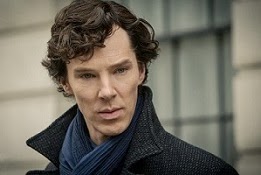 |
| Canonical Nods in "The Empty Hearse" |
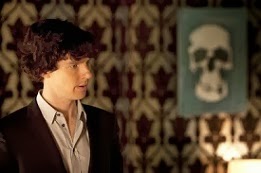 |
| Canonical Nods in "A Study in Pink" |


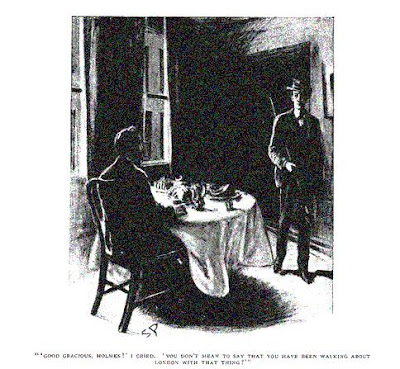
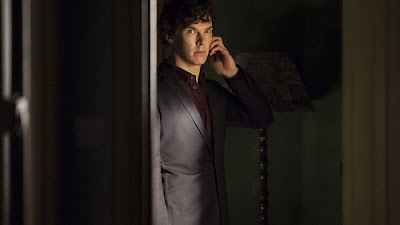
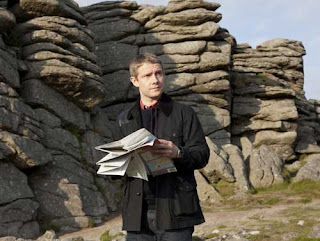

Very thorough! I recall not enjoying this one as much as some others. Writer Mark Gatiss seemed to have to turn cartwheels to update a plot that is very much in the horror genre and I don't feel he succeeded. The CGI doggy was rough too.
ReplyDeleteThanks GK. There are still a lot more references left, that I will be posting in the future.
DeleteGatiss used the plot element of The Adventure of the Devil's Foot in the climax. I thought that was a clever idea. Especially, how Sherlock came face to face with his own one and only fear: Moriarty.
But, to each his own. Thanks for stopping by!
B2B.
Didn't realise that! Might have to watch again!
DeleteSure GK. I am curious to see if your opinion changes after you re-watch the episode.
DeleteB2B.
I love all your 'canonical' references in Sherlock' posts. They always end up revealing stuff I've missed!
ReplyDeleteI maybe an exception but I really liked 'The Hounds of Baskerville' when I first saw it. The plot moves more slowly but the end did seem quite fitting (and I just connected the dots and realized it's similarity to The Devil's Foot on reading your comment above.) The John-miffed-with-Sherlock scene, the Lestrade-comes-in scene, the element of horror that is slowly but surely built up...it was different, but nice.
Well, thanks for this!
You are welcome :)
DeleteThank you for enjoying my posts so much and sharing your thoughts.
I too liked this episode when I first saw it. I found this episode to be more of a Sherlock Holmes adventure compared to the other two episodes in Season 2. Those two were too melodramatic for my taste.
Gatiss did a great job with the script. Especially, using The Devil's Foot to resolve the mystery. I thought that was rather ingenious.
B2B.
Was Sherlock Holmes being kind?
ReplyDeleteHe knows that he uses cocaine, has little patience with people at times, is constantly moving about on a case and so on, and he could get killed. So in not taking a wife, is Holmes simply being kind, knowing that if he did, marriage to him would be hell, and he doesn't want to wish that on anyone? Does he blot out any urge for this reason? Knowing that if he gave in, it would be a disaster for everyone?
Interesting theory!
DeleteB2B.
Sherlock's tobacco craze and impulsive announcement that he is going to Dartmoor is straight from the opening of Silver Blaze
ReplyDeleteThanks for stopping by and the comment.
DeleteI am not sure if either of these are a reference to the opening of Silver Blaze.
Sherlock's tobacco craze is possibly taken from The Yellow Face (as listed at #5 in the post).
About Sherlock's decision to go to Dartmoor, I do not think it was impulsive. Sherlock deliberately lying about his inability to go to Dartmoor and then agreeing to go might be a reference to the original novel, in which Holmes wants everyone (especially Stapleton) to think that he is in London. Later, he reveals that he has been carrying out his investigation in secrecy (with the sole exception of Cartwright).
In Silver Blaze too, Holmes did not make an impulsive choice but made the mistake of not going earlier to the scene of the crime as he did not expect the famous horse to stay undetected for so long.
Arun.